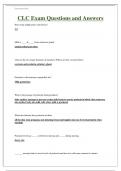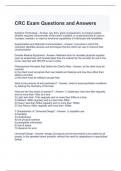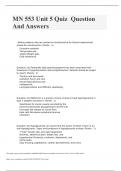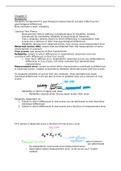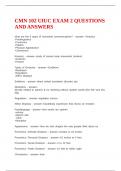CHAPTER 14
Related Rates
14.1 The top of a 25-foot ladder, leaning against a vertical wall is slipping down the wall at the rate of 1 foot per second.
How fast is the bottom of the ladder slipping along the ground when the bottom of the ladder is 7 feet away from
the base of the wall?
Fig. 14-1
I Let y be the distance of the top of the ladder from the ground, and let x be the distance of the bottom of the
ladder from the base of the wall (Fig. 14-1). By the Pythagorean theorem, x2 + y2 = (25)2. Differentiating
with respect to time t, 2x • D,x + 2y • D,y = 0; so, x • D,x + y • Dty = 0. The given information tells us that
D,y = -1 foot per second. (Since the ladder is sliding down the wall, y is decreasing, and, therefore, its
derivative is negative.) When x = 7, substitution in x2 + y2 = (25)2 yields y2 = 576, y = 24. Substitu-
tion in x • Dtx + y • D,y = 0 yields: 7 • D,x + 24 • (-1) = 0, D,x = ™ feet per second.
14.2 A cylindrical tank of radius 10 feet is being filled with wheat at the rate of 314 cubic feet per minute. How fast is
the depth of the wheat increasing? (The volume of a cylinder is nr2h, where r is its radius and h is its height.)
I Let V be the volume of wheat at time t, and let h be the depth of the wheat in the tank. Then V= ir(W)2h.
So, D,V = 1007T • D,h. But we are given that DtV= 314 cubic feet per minute. Hence, 314 = lOO-tr • D,h,
D,h = 314/(1007r). If we approximate TT by 3.14, then D,h = l. Thus, the depth of the wheat is increasing at
the rate of 1 cubic foot per minute.
14.3 A 5-foot girl is walking toward a 20-foot lamppost at the rate of 6 feet per second. How fast is the tip of her
shadow (cast by the lamp) moving?
Fig. 14-2
I Let x be the distance of the girl from the base of the post, and let y be the distance of the tip of her shadow
from the base of the post (Fig. 14-2). AABC is similar to ADEC. Hence, ABIDE = y / ( y - x), f =
yl(y-x), 4 = y / ( y - x ) , 4y-4x = y, 3y = 4x. Hence, 3 • D,y = 4 • D,x. But, we are told that D,x=-6
feet per second. (Since she is walking toward the base, x is decreasing, and D,x is negative.) So 3 • D,y =
4 • (-6), Dty = -8. Thus the tip of the shadow is moving at the rate of 8 feet per second toward the base of the
post.
14.4 Under the same conditions as in Problem 14.3, how fast is the length of the girl's shadow changing?
I Use the same notation as in Problem 14.3. Let ( be the length of her shadow. Then ( = y - x. Hence,
88
, RELATED RATES 89
D,t = D,y - D,x = (-8) - (-6) = -2. Thus, the length of the shadow is decreasing at the rate of 2 feet per
second.
14.5 A rocket is shot vertically upward with an initial velocity of 400 feet per second. Its height s after t seconds is
s = 400( — 16t2. How fast is the distance changing from the rocket to an observer on the ground 1800 feet away
from the launching site, when the rocket is still rising and is 2400 feet above the ground?
Fig. 14-3
I Let M be the distance from the rocket to the observer, as shown in Fig. 14-3. By the Pythagorean theorem,
w2 = s2 + (1800)2. Hence, 2u • D,u = 2s • D,s, u-D,u = s-D,s. When s = 2400, u2 = (100)2 • (900), u =
100-30 = 3000. Since s = 400/-16/2, when s = 2400, 2400 = 400f - I6t2, t2 - 251 + 150 = 0,
(t - W)(t - 15) = 0. So, on the way up, the rocket is at 2400 feet when / = 10. But, D,s = 400 - 32;. So,
when t=W, D,s = 400 - 32 • 10 = 80. Substituting in u-D,u = s-Dts, we obtain 3000 • D,u = 2400 • 80,
D,u = 64. So the distance from the rocket to the observer is increasing at the rate of 64 feet per second when
14.6 A small funnel in the shape of a cone is being emptied of fluid at the rate of 12 cubic centimeters per second. The
height of the funnel is 20 centimeters and the radius of the top is 4 centimeters. How fast is the fluid level
dropping when the level stands 5 centimeters above the vertex of the cone? (Remember that the volume of a
cone is \irr2h.)
Fig. 14-4
I The fluid in the funnel forms a cone with radius r, height h, and volume V. By similar triangles, r/4 = /i/20,
r=h/5. So, V=^irr2h=$Tr(h/5)2h= Jsirh3. Hence, D,V= ^trh2 • D,h. We are given that D,V=
— 12, since the fluid is leaving at the rate of 12 cubic centimeters per second. Hence, -12 = ^irh2 • D,h,
-300 = irh2 • D,h. When h = 5, -300= -rr -25 • D,h, Dlh = ~l2/Tr, or approximately -3.82 centimeters
per second. Hence, the fluid level is dropping at the rate of about 3.82 centimeters per second.
14.7 A balloon is being inflated by pumped air at the rate of 2 cubic inches per second, How fast is the diameter of the
balloon increasing when the radius is { inch?
Related Rates
14.1 The top of a 25-foot ladder, leaning against a vertical wall is slipping down the wall at the rate of 1 foot per second.
How fast is the bottom of the ladder slipping along the ground when the bottom of the ladder is 7 feet away from
the base of the wall?
Fig. 14-1
I Let y be the distance of the top of the ladder from the ground, and let x be the distance of the bottom of the
ladder from the base of the wall (Fig. 14-1). By the Pythagorean theorem, x2 + y2 = (25)2. Differentiating
with respect to time t, 2x • D,x + 2y • D,y = 0; so, x • D,x + y • Dty = 0. The given information tells us that
D,y = -1 foot per second. (Since the ladder is sliding down the wall, y is decreasing, and, therefore, its
derivative is negative.) When x = 7, substitution in x2 + y2 = (25)2 yields y2 = 576, y = 24. Substitu-
tion in x • Dtx + y • D,y = 0 yields: 7 • D,x + 24 • (-1) = 0, D,x = ™ feet per second.
14.2 A cylindrical tank of radius 10 feet is being filled with wheat at the rate of 314 cubic feet per minute. How fast is
the depth of the wheat increasing? (The volume of a cylinder is nr2h, where r is its radius and h is its height.)
I Let V be the volume of wheat at time t, and let h be the depth of the wheat in the tank. Then V= ir(W)2h.
So, D,V = 1007T • D,h. But we are given that DtV= 314 cubic feet per minute. Hence, 314 = lOO-tr • D,h,
D,h = 314/(1007r). If we approximate TT by 3.14, then D,h = l. Thus, the depth of the wheat is increasing at
the rate of 1 cubic foot per minute.
14.3 A 5-foot girl is walking toward a 20-foot lamppost at the rate of 6 feet per second. How fast is the tip of her
shadow (cast by the lamp) moving?
Fig. 14-2
I Let x be the distance of the girl from the base of the post, and let y be the distance of the tip of her shadow
from the base of the post (Fig. 14-2). AABC is similar to ADEC. Hence, ABIDE = y / ( y - x), f =
yl(y-x), 4 = y / ( y - x ) , 4y-4x = y, 3y = 4x. Hence, 3 • D,y = 4 • D,x. But, we are told that D,x=-6
feet per second. (Since she is walking toward the base, x is decreasing, and D,x is negative.) So 3 • D,y =
4 • (-6), Dty = -8. Thus the tip of the shadow is moving at the rate of 8 feet per second toward the base of the
post.
14.4 Under the same conditions as in Problem 14.3, how fast is the length of the girl's shadow changing?
I Use the same notation as in Problem 14.3. Let ( be the length of her shadow. Then ( = y - x. Hence,
88
, RELATED RATES 89
D,t = D,y - D,x = (-8) - (-6) = -2. Thus, the length of the shadow is decreasing at the rate of 2 feet per
second.
14.5 A rocket is shot vertically upward with an initial velocity of 400 feet per second. Its height s after t seconds is
s = 400( — 16t2. How fast is the distance changing from the rocket to an observer on the ground 1800 feet away
from the launching site, when the rocket is still rising and is 2400 feet above the ground?
Fig. 14-3
I Let M be the distance from the rocket to the observer, as shown in Fig. 14-3. By the Pythagorean theorem,
w2 = s2 + (1800)2. Hence, 2u • D,u = 2s • D,s, u-D,u = s-D,s. When s = 2400, u2 = (100)2 • (900), u =
100-30 = 3000. Since s = 400/-16/2, when s = 2400, 2400 = 400f - I6t2, t2 - 251 + 150 = 0,
(t - W)(t - 15) = 0. So, on the way up, the rocket is at 2400 feet when / = 10. But, D,s = 400 - 32;. So,
when t=W, D,s = 400 - 32 • 10 = 80. Substituting in u-D,u = s-Dts, we obtain 3000 • D,u = 2400 • 80,
D,u = 64. So the distance from the rocket to the observer is increasing at the rate of 64 feet per second when
14.6 A small funnel in the shape of a cone is being emptied of fluid at the rate of 12 cubic centimeters per second. The
height of the funnel is 20 centimeters and the radius of the top is 4 centimeters. How fast is the fluid level
dropping when the level stands 5 centimeters above the vertex of the cone? (Remember that the volume of a
cone is \irr2h.)
Fig. 14-4
I The fluid in the funnel forms a cone with radius r, height h, and volume V. By similar triangles, r/4 = /i/20,
r=h/5. So, V=^irr2h=$Tr(h/5)2h= Jsirh3. Hence, D,V= ^trh2 • D,h. We are given that D,V=
— 12, since the fluid is leaving at the rate of 12 cubic centimeters per second. Hence, -12 = ^irh2 • D,h,
-300 = irh2 • D,h. When h = 5, -300= -rr -25 • D,h, Dlh = ~l2/Tr, or approximately -3.82 centimeters
per second. Hence, the fluid level is dropping at the rate of about 3.82 centimeters per second.
14.7 A balloon is being inflated by pumped air at the rate of 2 cubic inches per second, How fast is the diameter of the
balloon increasing when the radius is { inch?



